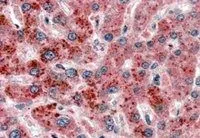
IHC-P analysis of human liver using GTX89330 HSD3a antibody, N-term. Antigen retrieval : citrate buffer pH 6 Dilution : 2.5microg/ml
HSD3a antibody, N-term
GTX89330
ApplicationsWestern Blot, ImmunoHistoChemistry, ImmunoHistoChemistry Paraffin
Product group Antibodies
TargetAKR1C4
Overview
- SupplierGeneTex
- Product NameHSD3a antibody, N-term
- Delivery Days Customer7
- Application Supplier NoteWB: 0.1-0.3microg/ml. IHC-P: 2-4microg/ml. *Optimal dilutions/concentrations should be determined by the researcher.Not tested in other applications.
- ApplicationsWestern Blot, ImmunoHistoChemistry, ImmunoHistoChemistry Paraffin
- CertificationResearch Use Only
- ClonalityPolyclonal
- Concentration0.50 mg/ml
- ConjugateUnconjugated
- Gene ID1109
- Target nameAKR1C4
- Target descriptionaldo-keto reductase family 1 member C4
- Target synonyms3-alpha-HSD, C11, CDR, CHDR, DD-4, DD4, HAKRA, aldo-keto reductase family 1 member C4, 3-alpha-HSD1, 3alpha-hydroxysteroid 3-dehydrogenase, chlordecone reductase; 3-alpha hydroxysteroid dehydrogenase, type I; dihydrodiol dehydrogenase 4, dihydrodiol dehydrogenase isozyme DD4, type I 3-alpha-hydroxysteroid dehydrogenase
- HostGoat
- IsotypeIgG
- Protein IDP17516
- Protein NameAldo-keto reductase family 1 member C4
- Scientific DescriptionThis gene encodes a member of the aldo/keto reductase superfamily, which consists of more than 40 known enzymes and proteins. These enzymes catalyze the conversion of aldehydes and ketones to their corresponding alcohols by utilizing NADH and/or NADPH as cofactors. The enzymes display overlapping but distinct substrate specificity. This enzyme catalyzes the bioreduction of chlordecone, a toxic organochlorine pesticide, to chlordecone alcohol in liver. This gene shares high sequence identity with three other gene members and is clustered with those three genes at chromosome 10p15-p14. [provided by RefSeq, Jul 2008]
- Storage Instruction-20°C or -80°C,2°C to 8°C
- UNSPSC12352203
References
- Guo SS, Chen YZ, Liu LT, et al. Prognostic significance of AKR1C4 and the advantage of combining EBV DNA to stratify patients at high risk of locoregional recurrence of nasopharyngeal carcinoma. BMC Cancer. 2022,22(1):880. doi: 10.1186/s12885-022-09924-3Read this paper



